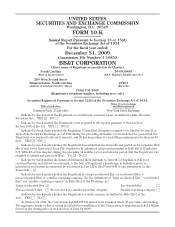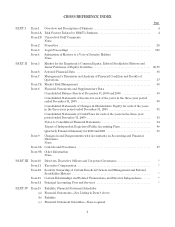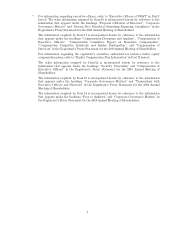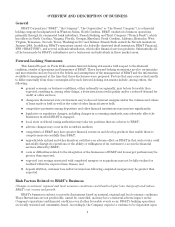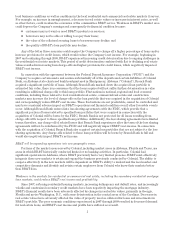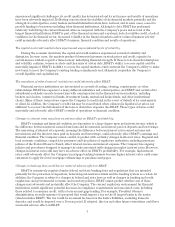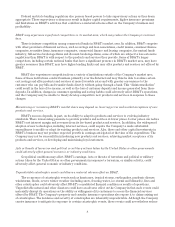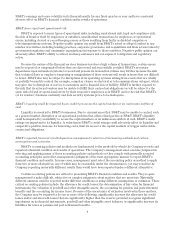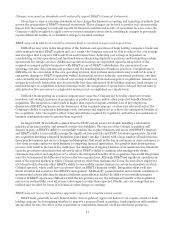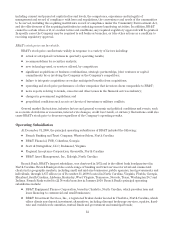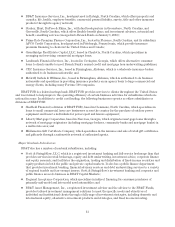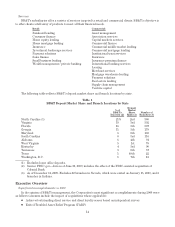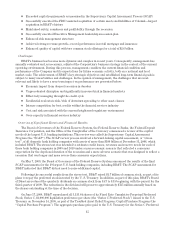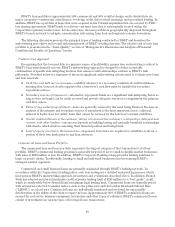BB&T 2009 Annual Report Download - page 9
Download and view the complete annual report
Please find page 9 of the 2009 BB&T annual report below. You can navigate through the pages in the report by either clicking on the pages listed below, or by using the keyword search tool below to find specific information within the annual report.BB&T’s earnings and cause volatility in its financial results for any fiscal quarter or year and have a material
adverse effect on BB&T’s financial condition and/or results of operations.
BB&T faces significant operational risk.
BB&T is exposed to many types of operational risks, including reputational risk, legal and compliance risk,
the risk of fraud or theft by employees or outsiders, unauthorized transactions by employees or operational
errors, including clerical or record-keeping errors or those resulting from faulty or disabled computer or
telecommunications systems. Negative public opinion can result from BB&T’s actual or alleged conduct in any
number of activities, including lending practices, corporate governance and acquisitions and from actions taken by
government regulators and community organizations in response to those activities. Negative public opinion can
adversely affect BB&T’s ability to attract and keep customers and can expose it to litigation and regulatory
action.
Because the nature of the financial services business involves a high volume of transactions, certain errors
may be repeated or compounded before they are discovered and successfully rectified. BB&T’s necessary
dependence upon automated systems to record and process its transaction volume may further increase the risk
that technical flaws or employee tampering or manipulation of those systems will result in losses that are difficult
to detect. BB&T also may be subject to disruptions of its operating systems arising from events that are wholly
or partially beyond its control (for example, computer viruses or electrical or telecommunications outages), which
may give rise to disruption of service to customers and to financial loss or liability. BB&T is further exposed to
the risk that its external vendors may be unable to fulfill their contractual obligations (or will be subject to the
same risk of fraud or operational errors by their respective employees as is BB&T) and to the risk that BB&T’s
(or its vendors’) business continuity and data security systems prove to be inadequate.
BB&T’s liquidity could be impaired by an inability to access the capital markets or an unforeseen outflow of
cash.
Liquidity is essential to BB&T’s businesses. Due to circumstances that BB&T may be unable to control, such
as a general market disruption or an operational problem that affects third parties or BB&T, BB&T’s liquidity
could be impaired by an inability to access the capital markets or an unforeseen outflow of cash. BB&T’s credit
ratings are important to its liquidity. A reduction in BB&T’s credit ratings could adversely affect its liquidity and
competitive position, increase its borrowing costs, limit its access to the capital markets or trigger unfavorable
contractual obligations.
BB&T’s reported financial results depend on management’s selection of accounting methods and certain
assumptions and estimates.
BB&T’s accounting policies and methods are fundamental to the methods by which the Company records and
reports its financial condition and results of operations. The Company’s management must exercise judgment in
selecting and applying many of these accounting policies and methods so they comply with generally accepted
accounting principles and reflect management’s judgment of the most appropriate manner to report BB&T’s
financial condition and results. In some cases, management must select the accounting policy or method to apply
from two or more alternatives, any of which may be reasonable under the circumstances, yet may result in the
Company reporting materially different results than would have been reported under a different alternative.
Certain accounting policies are critical to presenting BB&T’s financial condition and results. They require
management to make difficult, subjective or complex judgments about matters that are uncertain. Materially
different amounts could be reported under different conditions or using different assumptions or estimates. These
critical accounting policies include: the allowance for credit losses; the determination of fair value for financial
instruments; the valuation of goodwill and other intangible assets; the accounting for pension and postretirement
benefits and the accounting for income taxes. Because of the uncertainty of estimates involved in these matters,
the Company may be required to do one or more of the following: significantly increase the allowance for credit
losses and/or sustain credit losses that are significantly higher than the reserve provided; recognize significant
impairment on its financial instruments, goodwill and other intangible asset balances; or significantly increase its
liabilities for taxes or pension and post retirement benefits.
9

